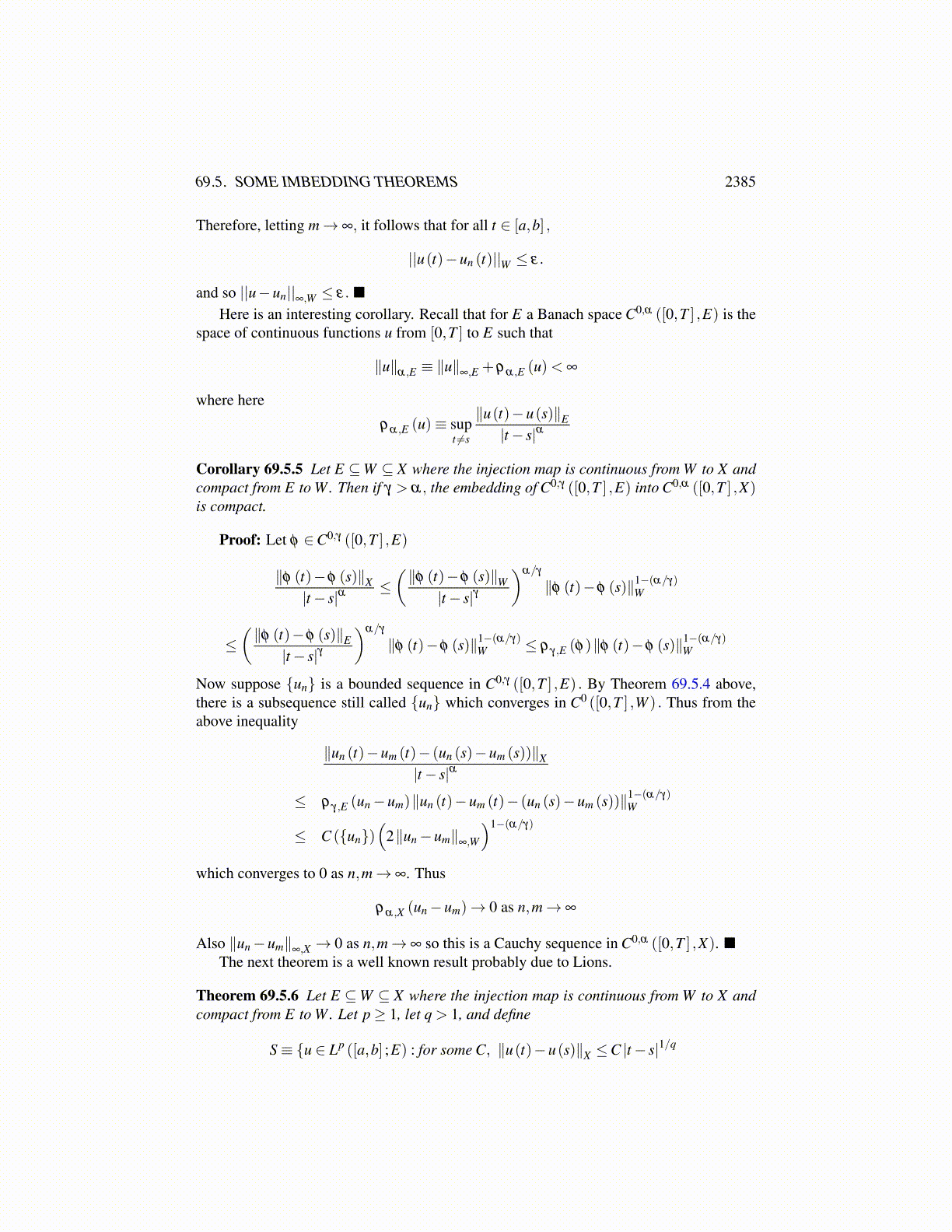
69.5. SOME IMBEDDING THEOREMS 2385
Definition 69.5.3 Define C ([a,b] ;X) the space of functions continuous at every point of[a,b] having values in X.
You should verify that this is a Banach space with norm
||u||∞,X = max
{∣∣∣∣unk (t)−u(t)∣∣∣∣
X : t ∈ [a,b]}.
The following theorem is an infinite dimensional version of the Ascoli Arzela theorem.It is like a well known result due to Simon. It is the appropriate generalization to stochasticproblems in which you do not have weak derivatives. See Theorem 65.12.1 on the Holdercontinuity of the stochastic integral.
Theorem 69.5.4 Let q > 1 and let E ⊆W ⊆ X where the injection map is continuous fromW to X and compact from E to W. Let S be defined by{
u such that ||u(t)||E ≤ R for all t ∈ [a,b] , and ∥u(s)−u(t)∥X ≤ R |t− s|1/q}.
Thus S is bounded in L∞ (0,T,E) and in addition, the functions are uniformly Holder con-tinuous into X . Then S ⊆ C ([a,b] ;W ) and if {un} ⊆ S, there exists a subsequence,
{unk
}which converges to a function u ∈C ([a,b] ;W ) in the following way.
limk→∞
∣∣∣∣unk −u∣∣∣∣
∞,W = 0.
Proof: First consider the issue of S being a subset of C ([a,b] ;W ) . Let ε > 0 be given.Then by Theorem 69.5.2 there exists a constant, Cε such that for all u ∈W
||u||W ≤ε
4R||u||E +Cε ||u||X .
Therefore, for all u ∈ S,
||u(t)−u(s)||W ≤ ε
6R||u(t)−u(s)||E +Cε ||u(t)−u(s)||X
≤ ε
6R(∥u(t)∥E +∥u(s)∥E)+Cε ∥u(t)−u(s)∥X
≤ ε
3+Cε R |t− s|1/q . (69.5.27)
Since ε is arbitrary, it follows u ∈C ([a,b] ;W ).Let D = Q∩ [a,b] so D is a countable dense subset of [a,b]. Let D = {tn}∞
n=1. Bycompactness of the embedding of E into W, there exists a subsequence u(n,1) such thatas n→ ∞, u(n,1) (t1) converges to a point in W. Now take a subsequence of this, called(n,2) such that as n→ ∞,u(n,2) (t2) converges to a point in W. It follows that u(n,2) (t1) alsoconverges to a point of W. Continue this way. Now consider the diagonal sequence, uk ≡u(k,k) This sequence is a subsequence of u(n,l) whenever k > l. Therefore, uk (t j) convergesfor all t j ∈ D.
Claim: Let {uk} be as just defined, converging at every point of D ≡ [a,b]∩Q. Then{uk} converges at every point of [a,b].